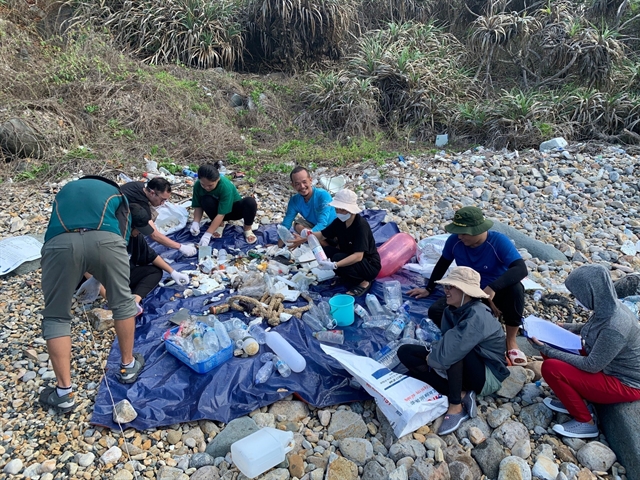 Society
Society

HÀ NỘI – Electronic waste can cause serious environmental consequences if not collected and processed properly although it does not account for a large proportion.
But in the context of the increasing amount of e-waste, collecting and processing e-waste effectively is an urgent issue, according to environment experts.
The United Nations predicts that developed countries globally emit about 65.4 million tonnes of electronic products each year. E-waste affects human health through soil, water, air pollution.
Current status of e-waste
Electronic waste is becoming increasingly common, alongside the rapid development of science and technology.
Nowadays, owning a mobile phone, TV, or computer is no longer luxury items of most people.
The prices of electronic devices are also gradually decreasing, making them affordable for the lower-income class.
Instead of repairing damaged electronic devices as before, people are now willing to discard heavily damaged electronics to buy new ones.
This has led to an increase in the amount of e-waste.
According to a research conducted by the Institute of Environmental Science and Technology, Việt Nam currently generates approximately 100,000 tonnes of e-waste annually, primarily household and office electronics.
It is estimated that by 2025, television waste alone could reach up to 250,000 tonnes.
Hà Nội and HCM City are the two localities with the highest amount of e-waste due to their dense populations and high demand for electronic devices.
Discarded electronics primarily include mobile phones, laptops, tablets, TVs, and small household appliances.
Improper disposal of e-waste not only increases the risk of environmental pollution but also wastes resources. Many components in electronic devices, such as precious metals, plastics, and glass, can be recycled and reused, reducing dependence on natural resources. However, e-waste recycling in Việt Nam is still not being effectively and comprehensively implemented.
Currently, collecting and processing e-waste in Việt Nam is still rudimentary, with many inadequacies.
The country has about 100 facilities for collecting and recycling e-waste, but recycling mainly remains at a manual level. Facilities applying advanced technology face challenges in terms of human resources, equipment investment, and lack of investment in science and technology transfer.
How to solve problem?
Electronic waste is a special type of waste that requires specific collection and processing methods to avoid environmental pollution.
Specifically, various types of e-waste contain many hazardous substances such as lead, mercury, cadmium, and other chemical compounds. If not handled properly, these substances can seep into the soil and water, causing severe environmental pollution and threatening human health.
Therefore, the collection and processing of e-waste must be carried out professionally and systematically.
Dr. Nguyễn Đức Quảng from Hà Nội University of Science and Technology told kinhtedothi.vn that one of the challenges in dealing with e-waste is that a single type of e-waste can contain up to 60 chemical elements making recycling extremely difficult.
Therefore, it is necessary to quickly find scientific solutions to handle e-waste to reduce the environmental pollution caused by e-waste, Quảng said.
“Another challenge is that the current state of recycling and processing electronic waste in Việt Nam remains at a low level,” Quảng said.
“Specifically, we are currently only recycling a portion of common materials such as iron, copper, lead, tin, and plastics using outdated technology and equipment, which have significant impacts on the environment and public health,” he said.
Meanwhile. Prof. Dr. Đặng Kim Chi, former deputy director of the Institute of Environmental Science and Technology at Hà Nội University of Science and Technology, said that most e-waste is currently sorted and recycled by traditional craft villages.
But labour safety practices at these facilities are very low, she said.
According to the expert, to address the issue of e-waste, Việt Nam needs to have a comprehensive strategy, from raising public awareness, strengthening state management, to promoting the participation of businesses in collecting and recycling e-waste.
One effective solution for collecting and processing e-waste is to implement a product recovery model, said Chi.
Accordingly, manufacturers and distributors of electronic devices will be responsible for collecting and processing their products after consumers no longer use them. This model has been successfully applied in several developed countries, she said.
In Việt Nam, some businesses have begun implementing e-waste recovery programmes, such as Samsung Electronics Việt Nam with the "Samsung Recycle" programme or Panasonic Group with the "Panasonic Eco" programme.
These programmes not only help reduce e-waste but also raise consumer awareness about environmental protection.
Moreover, active participation from the relevant authorities is needed in developing and enforcing policies and regulations on e-waste management.
Establishing e-waste collection points in residential areas, schools, agencies, and businesses is also a necessary solution to ensure e-waste is collected and processed correctly.
Investing in e-waste recycling technology is also an important factor.
Currently, e-waste recycling technology in Việt Nam is still very limited and outdated.
There is a need for strong investment in advanced technologies to ensure that e-waste is recycled effectively and environmentally friendly.
Technologies such as metal extraction through biological methods, waste treatment using plasma technology, or recycling plastics from e-waste need to be researched and applied, Chi said. VNS




